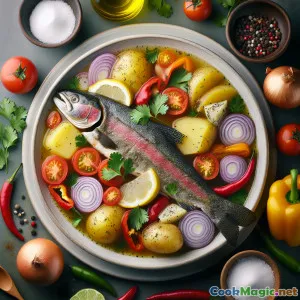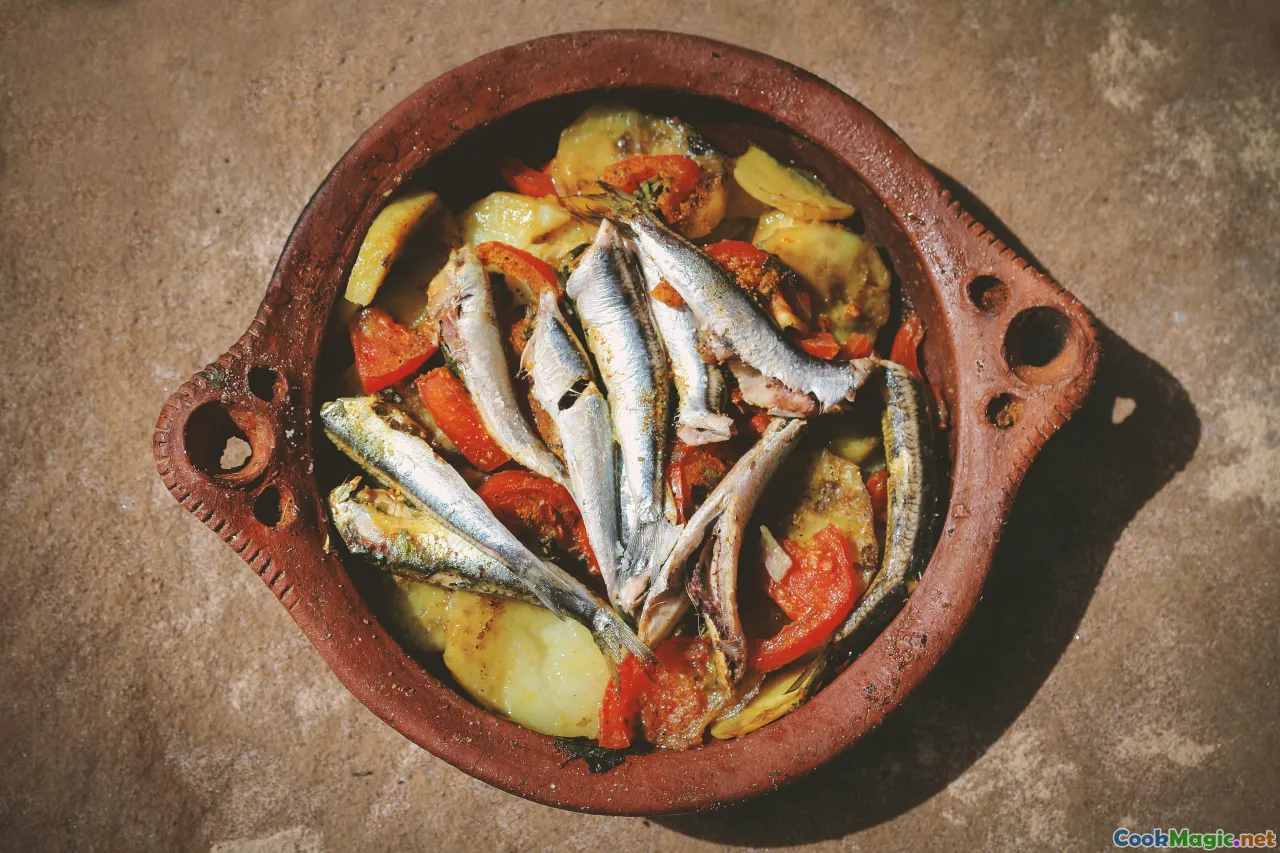
Cazuela copieuse de poisson du lac Titicaca
(Hearty Titicaca Lake Fish Cazuela)
(0 Avis)0
1,090
juillet 12, 2025
Signaler un problème
Ingrédients
-
600 grams Filets de poisson de lac frais (par exemple, truite ou pejerrey)
(Désossé et sans peau)
-
300 grams Pommes de terre jaunes
(Pelé et coupé en morceaux)
-
1 medium Poivron rouge
(Julienne)
-
1 medium Oignon
(Haché finement)
-
3 medium Tomates
(En dés)
-
3 pieces Gousses d'ail
(Haché)
-
15 grams Coriandre frais
(Haché)
-
1.5 liters Eau chaude ou bouillon de poisson
-
1 piece Piment jaune (ají amarillo)
(Égrainé et tranché, peut être remplacé par du piment doux)
-
1 teaspoon Sel
(Ajuster au goût)
-
0.5 teaspoon Poivre noir
(Fraîchement moulu)
-
2 tablespoons Huile végétale
(Pour sauter)
-
1 tablespoon Jus de citron vert
(Pressé à la minute)
(Désossé et sans peau)
(Pelé et coupé en morceaux)
(Julienne)
(Haché finement)
(En dés)
(Haché)
(Haché)
(Égrainé et tranché, peut être remplacé par du piment doux)
(Ajuster au goût)
(Fraîchement moulu)
(Pour sauter)
(Pressé à la minute)
Nutrition
- Portions: 4
- Taille de portion: 1 bol (environ 300 g)
- Calories: 390 kcal
- Carbohydrates: 40 g
- Protein: 35 g
- Fat: 8 g
- Fiber: 6 g
- Sugar: 6 g
- Sodium: 580 mg
- Cholesterol: 75 mg
- Calcium: 55 mg
- Iron: 1.8 mg
Instructions
-
1 - Préparer les légumes et le poisson:
Lavez et épluchez les pommes de terre ; hachez les oignons, tomates, poivrons ; émincez l’ail et retirez les graines du piment si vous en utilisez. Rincez et séchez les filets de poisson ; coupez-les en gros morceaux.
-
2 - Faire Sauter les Aromates:
Chauffez l'huile végétale dans une grande casserole à feu moyen. Ajoutez les oignons et l'ail, faites revenir jusqu'à ce qu'ils soient translucides. Ajoutez le piment jaune et le poivron ; cuisez jusqu'à ce qu'ils soient tendres.
-
3 - Ajouter des tomates et du bouillon:
Incorporez les tomates en dés et faites cuire pendant 5 minutes jusqu'à ce qu'ils soient tendres. Versez de l'eau chaude ou du bouillon de poisson, ajoutez les pommes de terre et portez à ébullition douce.
-
4 - Ragoût:
Réduisez le feu à moyen-doux, couvrez et laissez mijoter jusqu'à ce que les pommes de terre soient tendres (environ 15 minutes). Assaisonnez avec du sel et du poivre noir.
-
5 - Cuire du Poisson:
Ajoutez délicatement les morceaux de poisson dans la casserole, couvrez, et faites cuire jusqu'à ce que le poisson soit opaque et bien cuit (environ 5 minutes).
-
6 - Finition avec de la Coriandre et du Citron Vert:
Ajoutez de la coriandre hachée et du jus de citron vert si vous en utilisez. Ajustez l'assaisonnement. Servez chaud dans des bols.
Lavez et épluchez les pommes de terre ; hachez les oignons, tomates, poivrons ; émincez l’ail et retirez les graines du piment si vous en utilisez. Rincez et séchez les filets de poisson ; coupez-les en gros morceaux.
Chauffez l'huile végétale dans une grande casserole à feu moyen. Ajoutez les oignons et l'ail, faites revenir jusqu'à ce qu'ils soient translucides. Ajoutez le piment jaune et le poivron ; cuisez jusqu'à ce qu'ils soient tendres.
Incorporez les tomates en dés et faites cuire pendant 5 minutes jusqu'à ce qu'ils soient tendres. Versez de l'eau chaude ou du bouillon de poisson, ajoutez les pommes de terre et portez à ébullition douce.
Réduisez le feu à moyen-doux, couvrez et laissez mijoter jusqu'à ce que les pommes de terre soient tendres (environ 15 minutes). Assaisonnez avec du sel et du poivre noir.
Ajoutez délicatement les morceaux de poisson dans la casserole, couvrez, et faites cuire jusqu'à ce que le poisson soit opaque et bien cuit (environ 5 minutes).
Ajoutez de la coriandre hachée et du jus de citron vert si vous en utilisez. Ajustez l'assaisonnement. Servez chaud dans des bols.
En savoir plus sur: Cazuela copieuse de poisson du lac Titicaca
Ragoût de poisson du Lac Titicaca est un ragoût traditionnel de poisson bolivien qui célèbre l'abondance des poissons frais trouvés dans le majestueux lac Titicaca, le plus grand lac d'Amérique du Sud et le plus haut lac navigable du monde. Ce plat est un témoignage élégant de l'héritage culinaire andin, débordant des saveurs terreuses des pommes de terre jaunes — une culture native des Andes — et de légumes indigènes colorés.
La recette équilibre la protéine généreuse du poisson du lac, comme la truite ou le pejerrey, avec un bouillon teinté de safran mettant en vedette l’ají amarillo (piment jaune), pierre angulaire de la cuisine péruvienne et bolivienne. En faisant mijoter des légumes frais avec la base aromatique composée d’ail, d’oignons et de tomates, on développe une saveur riche et nuancée.
Historiquement, les peuples autochtones autour du lac Titicaca se sont largement appuyés sur la pêche et l'agriculture des tubercules, élaborant autour de ce plat une identité culinaire vive. Alors que ce plat mijote, la fusion du poisson frais du lac et des pommes de terre chaudes symbolise l'harmonie entre l’eau et la terre qui définit la région du lac.
Pour les cuisiniers, le ragoût offre une méthode de préparation relativement simple tout en apportant des couches de texture et d'épices complexes. Des techniques telles que plier délicatement le poisson fragile seulement à l’étape finale préservent la tendreté. Un jus de citron vert en option apporte une vivacité fraîche qui rehausse les saveurs du ragoût.
Astuce : Si l’ají amarillo n’est pas disponible, des poivrons jaunes ou orange doux avec une touche de flocons de piment peuvent apporter une chaleur similaire sans dominer le plat. Incorporer de la coriandre fraîche juste avant de servir pour renforcer la fraîcheur aromatique.
Cuisiner ce ragoût vous connecte directement à la culture culinaire bolivienne, riche d’ingrédients proches de la nature et d’histoires de résilience autochtone. Qu'il soit servi avec du maïs andin grillé ou du pain rustique, il offrira sans aucun doute un réconfortant mélange de saveurs des hautes terres et de sérénité du lac.
Le plat peut être adapté à différents niveaux de compétence, des cuisiniers débutants recherchant des repas simples tout-en-un, à des chefs plus expérimentés élaborant des saveurs de bouillon en couches. Il se démarque par ses ingrédients d'origine uniques, représentant un art culinaire autochtone sud-américain adapté à la cuisine moderne.



















